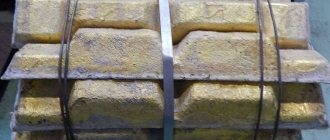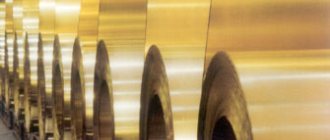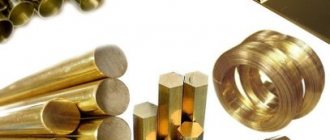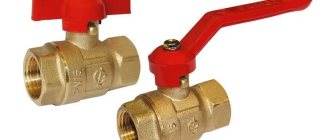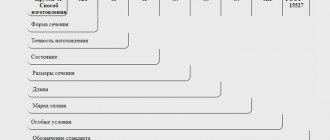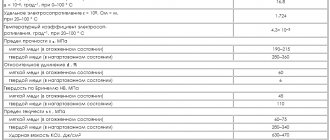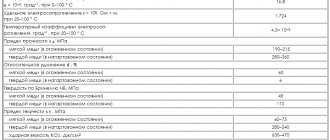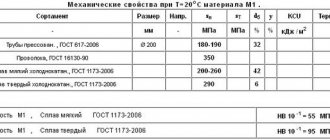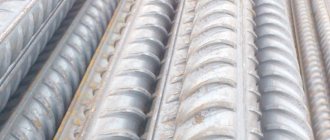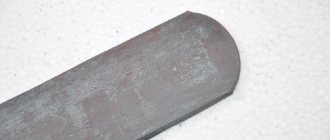Decoding the alloy grade and its characteristics
The interpretation of L63 is as follows: L indicates brass, and the numbers indicate the presence of 62-65% copper in the composition. Single-phase structure promotes ease of processing. The production of brass L63 is regulated by GOST 15527-2004; it is used not only for practical but also for decorative purposes.
Among the key characteristics of L63 brass alloys is increased corrosion resistance compared to copper. The material exhibits these qualities:
- in the marine environment;
- in alcohol solutions;
- in fresh water;
- among halogen gases.
The material has good casting characteristics. Suitable for gas and electric welding. Melts at a temperature of 906 °C. During the melting process, components harmful to the human body are formed, so the procedure is carried out in ventilated rooms. The zinc present in the composition is flammable. The wear resistance is increased by hot firing.
This is interesting: Bronze
Safety requirements
- It is advisable to melt brass outdoors under a canopy. If the workplace is indoors, provide good ventilation;
- There should be no flammable objects, explosive liquids, or gas cylinders in the immediate vicinity of the stove;
- You must have a fire extinguisher and a large container of water in an accessible place near your desk;
- The work is carried out in overalls made of cotton fabric, shoes should be made of thick leather;
- The visual organs are protected with glasses, the respiratory organs with a respirator;
- On the approach to the workplace, tables with casting molds, there should be no foreign objects or wires that can get caught;
- When pouring molten metal into a mold, you should try to avoid splashes;
- The premises must have a first aid kit containing everything necessary to provide first aid.
Phase state of matter in alloy L63
Alloys are single-phase and two-phase. Two-component alloys, including L63, mainly belong to single-phase structures. When the second phase appears, the mechanical properties of products decrease: fragility and hardness increase, and the ductility of products decreases. For this reason, two-phase a+b brasses are difficult to work with pressure. Single-phase alloys are as well processed by pressure as they are cast into ingots. L63 - contains a small amount of substance in the b-phase, therefore it lends itself well to pressure processing: rolling, deep drawing, embossing, drawing, bending without serious consequences, subject to the processing regime.
This alloy is used to produce:
- Tape L63
- Plate L63
- Pipe L63
- Wire L63
- Circle L63
- Sheet L63
- Rod L63
According to GOST 15527, L63A blanks with antimagnetic properties are also produced. The alloy is suitable for casting, but has limitations in cutting and machining.
Brass.
Plain brass.
| brand | chemical composition | appointment | ||
| Cu | Al | Pb | Sn | other |
| Plastic brasses (single-phase), deformable in cold and hot states | ||||
| L96 (tompak) | 95,0–97,0 | Radiator tubes, sheets, tapes. | ||
| L80 (semi-tompak) | 79,0–81,0 | Tubes, tape, wire. | ||
| L68 | 67,0–70,0 | Sheets, tapes for deep drawing. | ||
| Brasses of less ductility (two-phase), hot deformable and casting. | ||||
| LS59–1 | 57,0–60,0 | 0,8–1,9 | Sheets, pipes, castings; good machinability. |
Sophisticated brass.
| brand | chemical composition | appointment | ||
| Cu | Al | Pb | Sn | other |
| Complex brass workable (single phase) | ||||
| LA 77–2 | 76,0–79,0 | 1,7–2,5 | Pipes in marine and general engineering | |
| LO70–1 | 69,9–71,0 | 1–1,5 | Heater pipes | |
| Casting complex brasses (two-phase) according to GOST 17711–72 | ||||
| LA 67–2.5 | 66–68 | 2–3 | <=1,0 | Castings in marine and general engineering |
Complex brass with increased strength and resistance to corrosion.
Physical and mechanical properties
Alloy L63 is double, the structure is single-phase. Compared to copper, it has higher strength, hardness, ductility, elasticity and corrosion resistance. With increasing zinc content, these indicators increase. The greatest practical value for the crystallization of alloys based on copper and zinc are compounds with a zinc content of up to 50%. This number includes brass L63.
Structure
According to the Cu-Zn phase diagram, depending on the composition (zinc content from 0 to 39%), the material is a single-phase brass consisting of an a-solid solution with an equilibrium structure. This amount of zinc allows the alloy to crystallize in an equilibrium state, forming a face-centered cubic lattice (FCC), which achieves its plastic state. An increase in the zinc content in single-phase brasses is accompanied by an increase in their strength and ductility.
Plastic
The relative elongation of the material in the cold state, which characterizes its plasticity, is 55%. In the annealed state, L63 brass is the least ductile. But in the stage of applying cold deformation, plasticity persists for a long period. Higher plastic characteristics of the alloy are noticed when using soft stress state schemes during the deformation of the material, which is taken into account when predicting the possible destruction of the metal.
Susceptibility to processing
L63 is a single-phase alloy, in the b phase, which reduces the mechanical properties of products, contains a negligible amount of substance, and therefore lends itself well to pressure processing at low temperatures:
- minting;
- rolling;
- bending;
- deep drawing;
- drawing
The processed material requires strict adherence to the cooling regime.
Some alloy parameters
Compared to copper, the thermal conductivity and electrical conductivity of L63 brass due to the high zinc content is lower, and the workability is 2 times higher. The impact strength of the alloy is worse than that of L68, but better than that of multi-component brass.
Characteristics of brass L63:
- electrical resistivity – 0.065;
- impact strength – 14;
- machinability – 40%;
- thermal conductivity – 0.25.
Specific gravity of brass l63 - 8.44 g/cm
3
. The coefficient of friction with lubrication is 0.012, without lubrication - 0.390. Fluid flow - 65 cm, linear shrinkage - 1.77%. Brinnell hardness – 150-160 MPa.
Strength
Alloy L63 has the greatest strength in the cold state. The shear strength is 240 MPa. According to this indicator, the metal is inferior to brass L59-1. The tensile strength (ultimate strength) of double brass L63 in the state of extreme hardening is 735 MPa. The tensile strength of a hard alloy for rolling is in the range of 680-750 MPa, for a soft alloy - 380-450 MPa.
Melting temperature
The temperature range for thermomechanical and heat treatment of this metal is less than for other double brasses. The melting point of brass L63 is 906°C.
Due to the fact that with an increase in the zinc content in the brass alloy, the melting temperature decreases, in order to avoid burnout of the workpieces and their overheating, the temperature of hot processing is reduced to 750-880, and annealing - to 550-660°C.
At the same hot deformation temperature, brass L63 has the lowest values of deformation resistance. The conditional yield strength of the alloy is 700 MPa.
Temperature conditions for processing double brass grade 63:
- casting – 1060-1100°C;
- hot deformation – 650-850;
- beginning of recrystallization – 350-370
; - complete annealing – 660-670°C.
Corrosion resistance
Brass grade L63 in a cold state is subject to corrosion (seasonal) cracking and dezincification (dissolution in an aqueous environment). After the brass dissolves, due to an exchange reaction, copper precipitates from the solution. The copper film has a spongy appearance and creates a galvanic couple with brass, which accelerates the corrosion process. Dezincification occurs more intensively with increasing temperature of the environment and increasing the speed of water movement.
Causes
The main reasons leading to corrosion cracking of alloy L63:
- unfavorable environment (moisture and oxygen content, traces of ammonia, mercury salts, sulfur dioxide);
- the presence of residual tensile stresses in the metal;
Seasonal phenomena (autumn, spring), when air humidity and, accordingly, the ammonia content in it are increased, are considered especially unfavorable in terms of corrosion.
Internal residual stresses in the workpiece are divided into:
- the first kind (zonal), which are caused by the uneven distribution of deformations during pressure treatment of the material and uneven cooling of the workpiece after heat treatment;
- of the second kind, the causes of which are phase and structural transformations in the alloy.
Anti-cracking measures
To avoid corrosion cracking, use:
- low-temperature annealing of brass to reduce residual stress at 240-300°C;
- creation of compressive residual stresses in the outer layers of the workpieces;
carrying out other production activities aimed at reducing the limit of residual tensile stresses in the metal.
Resistance and instability to corrosion
L63 has increased anti-corrosion resistance in the following conditions:
- air environment;
- dry steam;
- fresh and sedentary sea water;
- dry halogen gas;
- alcohol, freon, antifreeze.
After processing on machines or by cutting, the L63 material loses its resistance to corrosion due to disruption of the crystal structure.
The instability of the alloy to corrosion cracking is observed upon contact:
- with mine waters;
- hydrogen sulfide;
- high pressure;
- fatty acids;
- wet saturated steam;
- oxidizing solutions;
- mineral acids;
- chlorides.
Thin-walled products are most susceptible to corrosion. It is not recommended to use L63 alloy in contact with zinc, aluminum and iron to avoid its accelerated destruction.
Alloy specific gravity
Let us recall that density is a quantity equal to the ratio of the mass of a body to the volume it occupies in space. Density is calculated using the following formula:
ρ = m/V.
In the case of multicomponent alloys, in which there is a simple mixing of chemical elements with a low enthalpy of formation, the following formula can be used to determine their density:
ρ = ∑imi/∑i(mi/ρi).
Where mi and ρi are the mass and density of the i-th component in the mixture.
Using the written formula, you can calculate the specific gravity of L63 brass. If the expression for ρ is written for two components, then we obtain the following equality:
ρ = ρzn*ρcu/(ρzn + x*(ρcu-ρzn)), where x = mzn/(mzn+mcu).
The x parameter reflects the mass fraction of zinc in the alloy. Since the atomic masses of the brass components are close, we can assume that the mass fraction is equal to the atomic one. If, for example, we take a composition of 63% Cu and 37% Zn and take into account that ρcu = 8960 kg/m3 and ρzn = 7140 kg/m3, then we obtain the value ρ = 8188 kg/m3.
Turning to the experimental value of the density of L63 brass, we see that it corresponds to 8440 kg/m3 at room temperature. The discrepancy with the theoretical result is due to two main factors:
- during the formation of an alloy, there is some negative enthalpy of mixing of the components;
- it contains impurities of heavier metals.
Structure and possible processing methods
The mechanical characteristics of brass of the brand in question, like any other material, are determined by the phase state of its internal structure. In the structure of L63 brass there is no second so-called b-phase, which, if present in a copper alloy, makes it harder and more brittle and significantly impairs the ductility of the base metal. It is the single-phase structure of the alloy of this brand that explains the fact that products made from it are perfectly amenable to pressure processing using almost any of the technologies used today (rolling, drawing, drawing, embossing, bending).
Structure of brass: single-phase (a) and two-phase (b)
Casting methods and cutting technologies are also used to manufacture products from L63 brass, which significantly expands the scope of its application. At industrial enterprises engaged in the production of metals, brass grade L63 is produced in the following form:
- rolled sheets, strips and plates;
- rods with different cross-sectional shapes;
- pipe products;
- wire.
Guaranteed mechanical properties of L63 brass sheets in comparison with L59-1 and copper sheets
The entire range of products made from L63 brass is specified by GOST 15527-70 (new edition - GOST 15527-2004). In addition, as GOST 15527-70 prescribes, manufacturers can produce blanks from a modification of this alloy (L63A), which are distinguished by antimagnetic properties. This alloy, having similar characteristics to L63 brass (specific gravity, density, etc.), has better fluidity in the molten state, but products made from it are not very well processed by cutting.
Application
Brass L63 is used for the manufacture of:
- pipes;
- sheets;
- wires;
- ribbons;
- foil;
- stripes;
- parts produced by deep drawing.
Finished products:
- pressure rollers for pickling work;
- tanks;
- screws;
- car parts;
- radiator tapes;
- zippers;
- fasteners;
- decorative elements of architecture and design;
- shut-off valve units;
- electrodes;
- rivets;
- couplings.
The material is most often used in the production of parts made by deformation with high requirements for corrosion resistance. Brass is used for welding, soldering, and processed on machines. The alloy is used to create church utensils, make costume jewelry, decorate books, and use them for monuments. Due to its similarity to gold, it is used as a counterfeit for making jewelry.
Rolled brass l63
- Rods: hard (diameter 3-12 mm), semi-hard (3-40 mm), soft (3-50 mm), pressed (10-180 mm).
- Circles for mass use.
- General purpose pipes (pressed and cold-formed).
- Boiler pipes.
- Mass-produced wire (conditions - soft, hard, semi-hard), with a diameter of 0.1-12 mm. Used as solder and for rivets.
High-precision L63 wire is used in the form of electrodes for electrical discharge machines. Plates are made from a sheet of this alloy, which become personalized when engraved.
Decorative use
Brass alloy L63, thanks to its beautiful golden-yellow color, is used for the manufacture of artistic products. They are coated with varnish, which gives the item a golden shine. Brass is galvanized - coated with silver, nickel, gold, and tinted in any color.
Brand L63 has the color of 583 gold, which is used in casting to imitate natural gold nuggets. The technology consists of casting a molten composition into cooled water in a large spatial form, not limited by walls. In this case, the casting acquires bizarre, uneven outlines, reminiscent of gold nuggets.
The shapes are obtained due to maximum cooling of the alloy in water at a temperature of 5-10°C. As a result of this process, with a sharp temperature difference, a high rate of crystallization of the outer layers of the casting occurs, deformation occurs, and an uneven surface is formed. In this case, the single-phase structure of the L63 alloy becomes similar to the structure of two-phase brasses, and the hardness of the material increases. Such castings can be used in jewelry design.
What negatively affects the anti-corrosion properties of L63
Sharp processing negatively affects the corrosion resistance of products made from L63 alloy. This happens due to the destruction of the crystalline structure of the material. Cutting also causes a lot of internal stress. Corrosion cracking is often observed on objects made of such material. The reasons for their appearance may be:
- high humidity;
- presence of ammonia in the operating environment;
- heat;
- wet vapors;
- high pressure
To protect against cracking, products are annealed at low temperatures. Corrosion resistance is also affected by contact with mineral acids, mine waters, chlorides, and hydrogen sulfide. Most often, cracking is observed on materials made of thin sheets. For example, on thin-walled pipes and containers. But under conditions of proper use, such products can last a good period.
This is interesting: Soldering copper pipes with your own hands - instructions and video
Standards
| Name | Code | Standards |
| Ribbons | B34 | GOST 10533-86 |
| Wire made of non-ferrous metals and their alloys | B74 | GOST 1066-90, GOST 12920-67, GOST 1066-2015, GOST 12920-2013, OST 4.021.104-92, OST 4.021.105-92, TU 1845-001-24020651-2000, TU 48-0818-8- 91, TU 48-21-5027-73, TU 48-21-781-85, TU 48-0820-428-92 |
| Welding and cutting of metals. Soldering, riveting | B05 | GOST 16130-90 |
| Ribbons | B54 | GOST 20707-80, GOST 15527-2004, GOST 2208-2007, OST 4.021.078-92, TU 48-21-357-90, TU 48-21-527-91, TU 48-0813-32-90, TU 48-0813-36-89, TU 48-0815-28-92, TU 48-21-177-91, TU 48-21-225-85, TU 48-21-246-82, TU 48-21-639 -79, TU 48-21-735-83, TU 48-0810-128-83, TU 48-21-334-90, TU 48-21-5005-90, TU 48-21-737-83 |
| Non-ferrous metals, including rare ones, and their alloys | B51 | GOST 28873-90, OST 4.021.009-92, TU 48-21-642-79 |
| Pipes made of non-ferrous metals and alloys | B64 | GOST 494-90, GOST 2622-75, GOST 11383-75, GOST 20900-75, GOST 494-2014, OST 4G 0.021.400-80, OST 4.021.123-92, OST 4.021.124-92, OST 4.021. 130-92, OOP 5.9243-87, TU 48-21-147-72, TU 48-21-5020-73, TU 48-21-558-76, TU 48-21-869-89 |
| Rods | B55 | GOST 6688-91, GOST 2060-2006, OST 4.021.020-92, OST 4.021.037-92, OST 4.021.041-92, TU 48-21-5063-73, TU 48-21-542-76 |
| Sheets and strips | B53 | GOST 931-90, OST 4.021.050-92, OST 4.021.067-92, TU 48-21-502-75 |
| Hard alloys, metal-ceramic products and metal powders | B56 | TU 14-22-95-95 |
| Classification, nomenclature and general norms | B50 | TU 48-21-132-89 |
| Long and shaped rolled products | B52 | TU 48-21-914-92 |
Melting point of brass l – Metalist's Handbook
L63 brass is a two-component simple alloy consisting of 62-65% copper, 34.22-37.5% zinc and up to 0.5% impurities. The following impurities may be present in the alloy: iron, phosphorus, tin, and lead. This is one of the most common brass alloys. You can buy brass on our website.
Description of the properties of the processed alloy (L63)
This section discusses the mechanical, physical and technological properties and chemical composition of L63 brass, which is used for cold deformation by deep drawing, drawing, rolling, embossing, bending; for the manufacture of cryogenic equipment products; suitable for soldering and welding; polishes well.
Mechanical properties at T=20 °C of the L63 material are given in table. 6
Table 6.
| State | uv | yT | E | d5 | KCU |
| MPa | MPa | GPa | % | MJ/m2 | |
| soft alloy | 380 | 135 | — | 45 | |
| hard alloy | 700 | 550 | 116 | 4 | 1,4 |
The physical properties of the L63 material are given in table. 7.
Table 7.
| bx106 | l | G | C | With |
| 1/Grad | W/(m deg) | kg/m3 | J/(kg K) | µOhm m |
| 20,5 | 110 | 8440 | 385 | 0,07 |
The friction coefficient of the L63 material is given in Table 8.
Table 8.
| Lubricated friction coefficient: | 0,012 |
| Friction coefficient without lubrication: | 0,39 |
The foundry and technological properties of the L63 material are given in Table 9.
fTable 9.
| Melting point, °C: | 906 |
| Hot processing temperature, °C: | 750 — 880 |
| Annealing temperature, °C: | 550 — 650 |
The chemical composition in % of the L63 material is given in table. 10.
Table 10.
| Fe | P | Cu | Pb | Zn | Sb | Bi | Impurities |
| up to 0.2 | up to 0.001 | 62 — 65 | up to 0.07 | 34,5 — 38 | up to 0.005 | up to 0.002 | only 0.5 |
Note: Zn is the base; percentage of Zn is given approximately
Mechanical properties:
| uv | — Short-term strength limit, |
| yT | — Limit of proportionality (yield strength for permanent deformation), |
| d5 | — Elongation at break, |
| E | — Modulus of elasticity of the first kind, |
| KCU | — Impact strength, |
| HB | — Brinell hardness, |
Physical properties:
| T | — Temperature at which these properties were obtained, |
| b | — Coefficient of thermal (linear) expansion (range 20° - T), |
| l | — Thermal conductivity coefficient (heat capacity of the material), |
| G | — Density of the material, |
| C | — Specific heat capacity of the material (range 20° - T ), |
| With | — Electrical resistivity, |
fWeldability:
| no limits | — welding is performed without heating and without subsequent heat treatment |
| limited weldability | — welding is possible when heated to 100-120 degrees. and subsequent heat treatment |
| difficult to weld | — to obtain high-quality welded joints, additional operations are required: heating to 200-300 degrees. during welding, heat treatment after welding |
Copper and zinc form, in addition to the main b - solution, a number of phases of the electronic type c, d, f. Most often, the structure of brass consists of b - or b + c - phases: b - phase - a solid solution of zinc in copper with a fcc crystal lattice of copper, a c - phase - ordered solid solution based on the chemical compound CuZn with a 3/2 electronic connection with the bcc lattice (Fig. 1)
At high temperatures, the b-phase has a disordered arrangement of atoms and a wide range of homogeneity. In this state, the β-phase is plastic. At temperatures below 454–468 °C, the arrangement of copper and zinc atoms in this phase becomes ordered, and it is designated c. The b phase, in contrast to the b-phase, is harder and more brittle; d - the phase is an electronic compound Cu5Zn8.
Casting, wrought and soft brasses.
Casting brass is intended for casting various corrosion-resistant, anti-friction and other parts into a mold, into the ground and in a centrifugal manner. You can find the chemical composition of casting brasses on the Internet, as well as mechanical properties and approximate values. Wrought brasses are subjected to all types of hot and cold pressure processing. By changing the pressure treatment modes, brasses with different mechanical properties are obtained: soft, hard, especially hard. Soft brass has high ductility. This is achieved by pressure treatment in the annealed state. The degree of softness of semi-finished products from such brasses is characterized by the magnitude of the tensile strength and relative elongation, and for strips and sheets, by the depth of extrusion according to Erikson.
Features of heat treatment and corrosion resistance
The product in question melts at a temperature of 906oC. In the range from 750oC to 880oC it still exhibits good ductility and can therefore be machined. An important stage in the production of alloy L63 is annealing, which is performed in the range of 550-650oC. As a result of this processing, two main processes occur:
- mechanical stress is relieved;
- metastable phases dissolve to form a single-phase structure.
The presence of mechanical stress is extremely undesirable for L63. It is known that the addition of zinc to copper leads to a significant improvement in its corrosion resistance, therefore all brasses are fairly chemically passive alloys. They are destroyed over time only in aggressive environments, for example in perchloric and nitric acids. However, the presence of stress in brass structures significantly reduces their corrosion resistance.
Due to the formation of the above-mentioned stresses, it is not recommended to subject L63 products to rapid cutting.
Chemical technique
The use of reagents is an effective but destructive way to distinguish between copper alloys. Chemical analysis takes place in several stages:
- The shavings are removed from brass and bronze.
- An aqueous nitric acid solution is prepared with a 1:1 ratio.
- The shavings are placed in various containers filled with an acid reagent.
- Each tank is heated to a boil after the chips have completely dissolved.
- The compositions are kept in a boiling state over low heat for 30 minutes.
The result is that the container with brass remains transparent, while a white tin precipitate forms in the bronze container. Naturally, the technology is not suitable for tin-free alloys.
Anti-corrosion characteristics
All brass alloys (and therefore L63 brass) have high corrosion resistance. They are also distinguished by lower thermal and electrical conductivity when compared with the base metal - copper. Alloy L63 exhibits its corrosion resistance best under the following conditions:
- when in an air environment, including one saturated with salt vapor (sea air);
- when operating products in fresh water;
- when in sea water with low mobility;
- in an environment containing a large amount of halogen gases;
- when exposed to steam whose humidity is low;
- in a liquid medium consisting of antifreeze, freon and alcohol solutions.
Technological characteristics of brass L63
The corrosion resistance of those L63 brass products that have been pre-processed by cutting is significantly reduced. This is explained by the fact that when performing such processing, the crystal structure of the alloy is disrupted, and significant internal stresses are also formed. Corrosion cracking may occur on the surface of products made from L63 brass, the main causes of which are:
- excess humidity;
- high ambient temperature;
- the presence of sulfur dioxide and ammonia vapors in the environment in which the product is operated.
To avoid such a phenomenon, which leads not only to a deterioration in the decorative properties of the product, but also to a decrease in its performance characteristics, experts recommend that parts made of L63 brass be subjected to preliminary annealing, performed at low temperatures.
Regardless of the brand, factors that significantly reduce the corrosion resistance of brass are:
- contact with fatty acids;
- finding the product in so-called mine waters;
- interaction with hydrogen sulfide;
- exposure of the product to high pressure and saturated wet steam;
- interaction with oxidizing solutions and chlorides;
- contact with acids of mineral origin.
Corrosion rate of brass in various environments
Of all the products for the production of which L63 brass is used, those made from thin-sheet material are most susceptible to oxidative corrosion processes. This, in particular, includes tanks and tanks for various purposes, which are widely in demand in almost all industries.
Rolled metal
Pipes in accordance with GOST 494 from LS59-1 are produced by pressing. In addition, a wide range of products from this material are produced in accordance with GOST. Since the alloy has low mechanical properties for pressure processing, although it is generally considered pressure-processable, pipes are made from it using continuous casting methods. And their cost is much lower than pressed ones.
Cold-deformed general-purpose wire is produced in accordance with GOST 1066, and has a square, round or hexagonal cross-section.
Cold-worked sheets LS59-1 have high hardness and wear resistance, and, as mentioned above, are used in machine tool construction. This is one of the most popular types of rolled brass sheets. In addition, sheets are produced from LS59-1 in soft, semi-hard, and hard states.
LS59-1 bars of hexagonal and square shape have found the greatest use. This is a very inexpensive type of rolled product that is easy to cut, and in addition, it has strong ribs. Thanks to this, at minimal cost it is possible to produce all kinds of small and large parts with good anti-friction properties from rods. This alloy is used to produce drawn and pressed rods in hard, soft or semi-hard states.
Semi-finished products from brass L63. Application
L63, as mentioned earlier, is most widely used in all areas of industry.
Wire from this alloy is available in soft, semi-hard and hard states. It is used for the manufacture of rivets, due to the good ductility of this material, it is used as solder, and electrodes for electroerosive machines are produced from high-precision wire.
L63 pipes come in cold-deformed or pressed form and are widely used everywhere, in particular as pipes for boilers.
A wide range of sheet metal products is produced from L63 alloy. The alloy has high ductility and strength compared to Cu. But the best performance in this regard is given by the L68 alloy.
L63 rods are supplied in bulk, in solid, semi-solid, solid state, or pressed, with a diameter from 3 to 180 mm. Among other two-component brasses, this alloy stands out for its highest shear strength, high resistivity and excellent machinability. In terms of impact strength, L63 is inferior to alloys with 68% copper content, but is significantly superior to multicomponent alloys. In terms of shear strength, L63 is inferior to L59-1. The thermal and electrical conductivity of the alloy with 63% Cu is relatively low.
Corrosion resistance of material LS59-1
After processing brass blanks LS59-1
, the material does not experience strong stress, lead forms a separate phase, for this reason, it is more resistant to seasonal cracking, which manifests itself with increasing humidity and ambient temperature, in which it is superior to L68 and L63.
In general, our multi-component alloy is resistant to corrosion, under the same conditions as most brasses. It should not be used in contact with Fe, Al, Zn. He also shows himself poorly:
- in air saturated with moist vapors, at high pressure,
- in contact with fatty acids,
- in hydrogen sulfide,
- mine waters,
- mineral acids,
- as well as in oxidized solutions,
- and with chlorides.
Resistance to corrosion is manifested by:
- in air and maritime climates,
- in dry vapors,
- fresh waters,
- freons, alcohols, antifreezes,
- salty sea water in a sedentary state.
And the presence of excess oxygen, ammonia or carbon dioxide in vapor or water negatively affects the corrosion resistance of this material.
Chemical composition of L63 alloy used for the production of brass pipes
A popular material for brass pipes is L63 alloy, which in its chemical composition must meet the requirements of GOST 15527-2004. L63 brass is a two-component alloy containing from 62 to 65 percent copper and 43.22 to 37.5 percent zinc. A feature of the copper-zinc alloy of this category is that a significant part of the copper is replaced by zinc, which helps reduce the cost of products with high performance characteristics. Many consumers of brass alloy L63 also highlight the quality of its aesthetic appearance, which allows it to be used not only for the manufacture of products used in industry (brass pipes, wire, rods, etc.), but also for decorative products.
| Fe | P | Cu | Pb | Zn | Sb | Bi | Impurities |
| up to 0.2 | up to 0.01 | 62 — 65 | up to 0.07 | 34.22 — 37.5 | up to 0.005 | up to 0.002 | up to 0.5 |
Pure physics
GOST 15527-2004. copper-zinc alloys (brass), processed by pressure. brands (with change n 1)
The density of copper alloys is the next criterion for distinguishing brass from bronze. However, the popular belief that scales will give a definite answer is incorrect. Confirmation of this is provided by connection densities:
- rolled brass – 8.4 – 8.7;
- yellow brass – 8.43;
- bronze – 7.4 – 8.9.
All values are given in g/cc. As you can see, the weight of bronze, like its color, is highly dependent on the tin content. When its inclusion is at the level of 8%, the connection density is minimal and lower than that of brass. An increase in tin content leads to a heavier alloy. The result is that such bronze weighs more than brass. Therefore, using mass as a distinguishing criterion for copper alloys is not recommended in practice.
This video outlines the principle of calculating and determining metal based on weight and density:
